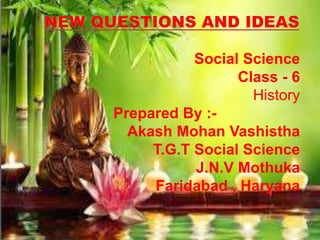
ppt new questions and ideas history class 6
- 1. Social Science Class - 6 History Prepared By :- Akash Mohan Vashistha T.G.T Social Science J.N.V Mothuka Faridabad , Haryana
- 2. TOPICS :- 1. The story of the Buddha 2. Upanishads 3. Jainism 4. The Sangha 5. Monasteries 6.The system of ashramas
- 3. The story of the Buddha Siddhartha, also known as Gautama. Born - 2500 years ago . The Buddha belonged to a small gana known as the Sakya gana, and was a kshatriya. He left the comforts of his home in search of knowledge.
- 4. Meeting and holding discussions with other thinkers. He finally decided to find his own path to realisation. Meditated for days . Under a peepal tree at Bodh Gaya in Bihar, where he attained enlightenment(knowled ge).
- 5. He then went to Sarnath, near Varanasi, where he taught for the first time. He spent the rest of his life travelling on foot, going from place to place, teaching people. He passed away at Kusinara.
- 8. He also taught people to be kind, and to respect the lives of others, including animals. He believed that the results of our actions (called karma), whether good or bad, affect us both in this life and the next. The Buddha taught in the language of the ordinary people, Prakrit, so that everybody could understand his message.
- 11. UPANISHADS
- 12. UPANISHADS Some of thinkers wanted to know about life after death, others wanted to know why sacrifices should be performed. Many of these thinkers felt that there was something permanent in the universe that would last even after death. Many of their ideas were recorded in the Upanishads. Upanishad literally means ‘approaching and sitting near’ and the texts contain conversations between teachers and students.
- 13. Most Upanishadic thinkers were men, especially brahmins and rajas. Women thinkers, such as Gargi, who was famous for her learning, and participatedin debates held in royal courts. Poor people rarely took part in these discussions. One famous exception was Satyakama Jabala, who was named after his mother, the slave woman Jabali. Many of the ideas of the Upanishads were later developed by the famous thinker Shankaracharya.
- 14. Panini, the grammarian This was also the time when other scholars were at work. One of the most famous was Panini, who prepared a grammar for Sanskrit. He arranged the vowels and the consonants in a special order, and then used these to create formulae like those found in Algebra
- 15. Jainism The last and 24th tirthankara of the Jainas, Vardhamana Mahavira . 2500 years ago. He was a kshatriya prince of the Lichchhavis, a group that was part of the Vajji sangha .
- 18. Followers of Mahavira, who were known as Jainas, had to lead very simple lives, begging for food. They had to be absolutely honest, and were especially asked not to steal.
- 19. Jainism was supported mainly traders. Farmers, who had to kill insects to protect their crops, found it more difficult to follow the rules.
- 20. The sangha Both the Mahavira and the Buddha felt that only those who left their homes could gain true knowledge. They arranged for them to stay together in the sangha, an association of those who left their homes. The rules made for the Buddhist sangha were written down in a book called the Vinaya Pitaka .
- 21. Who could join Sangha ? All men could join the sangha. Children had to take the permission of their parents . Slaves that of their masters. Those who worked for the king had to take his permission and debtors that of creditors. Women had to take their husbands’ permission.
- 22. Men and women who joined the sangha ledsimple lives. They meditated for most of the time, and went to cities and villages to beg for food during fixed hours. That is why they were known as bhikkhus (the Prakrit word for renouncer — beggar) and bhikkhunis. They taught others, and helped one another.
- 23. Monasteries Both Jaina and Buddhist monks went from place to place throughout the year, teaching people. The only time they stayed in one place was during the rainy season, when it was very difficult to travel. Then,their supporters built temporary shelters for them in gardens, or they lived in natural caves in hilly areas .
- 24. As time went on, felt the need for more permanent shelters and so monasteries were built.These were known as viharas
- 25. The system of ashramas Brahmins developed the system of ashramas. Four ashramas were recognised: Brahmacharya, Grihastha, Vanaprastha Samnyasa .
- 26. ASSIGNMENT :- 1.From which gana Buddha belonged ? 2. What were the teachings of Buddha ? 3. What was the language used by buddha to his messages ? 4. Who was Panini ? 5.What were the teachings of Mahavira ? 6. Who supported Jainism ? 7. What do you mean by viharas ? 8.Do you think it would have been easy for slaves to join the sangha.
- 27. THANKS
